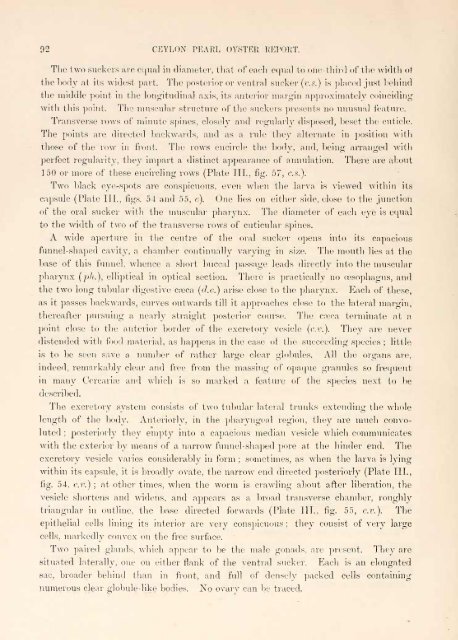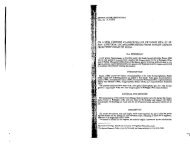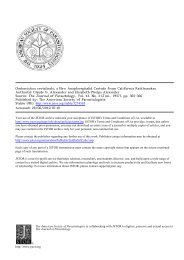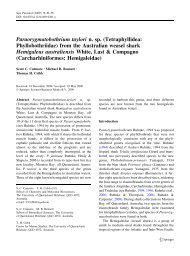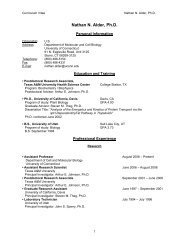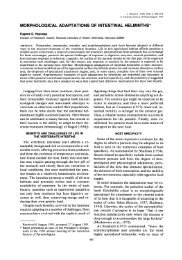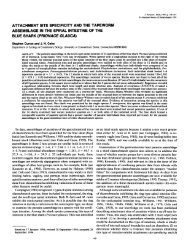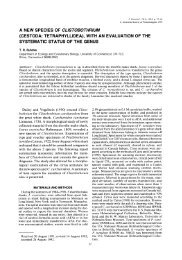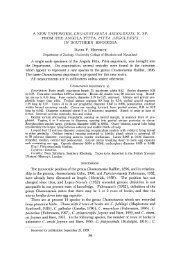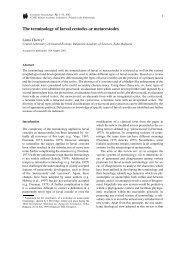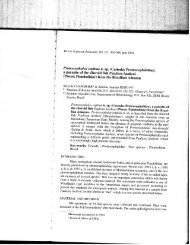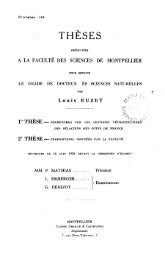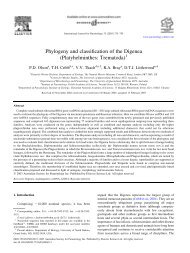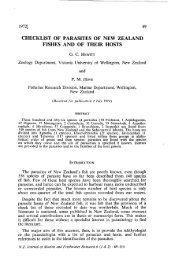PEARL OYSTER FISHERIES MARINE BIOLOGY OF CEYLON,
PEARL OYSTER FISHERIES MARINE BIOLOGY OF CEYLON,
PEARL OYSTER FISHERIES MARINE BIOLOGY OF CEYLON,
Create successful ePaper yourself
Turn your PDF publications into a flip-book with our unique Google optimized e-Paper software.
92 <strong>CEYLON</strong> <strong>PEARL</strong> OYSTEE REPORT.The two suckers are equal in diameter, that of each equal to one-third of the width otthe body at its widest part.The posterior or ventral sucker (v.s.) is placed just behindthe middle point in the longitudinal axis, its anterior margin approximately coincidingwith this point.The muscular structure of the suckers presents no unusual feature.Transverse rows of minute spines, closely and regularly disposed, beset the cuticle.The points are directed backwards, and as a rule they alternate in position withthose of the row in front. The rows encircle the body, and, being arranged withperfect regularity, they impart a distinct appearance of annulation. There are about150 or more of these encircling rows (Plate III., fig. 57, c.s.).Two black eye-spots are conspicuous, even when the larva is viewed within itscapsule (Plate III., figs.54 and 55, e).One lies on either side, close to the junctionof the oral sucker with the muscular pharynx. The diameter of each eye is equalto the width of two of the transverse rows of cuticular spines.A wide aperture in the centre of the oral sucker opens into its capaciousfunnel-shaped cavity, a chamber continually varying in size. The mouth lies at thebase of this funnel, whence a short buccal passage leads directly into the muscularpharynx (ph.), elliptical in optical section. There is practically no oesophagus, andthe two long tubular digestive creca (d.c.)arise close to the pharynx. Each of these,as it passes backwards, curves outwards till itapproaches close to the lateral margin,thereafter pursuing a nearly straight posterior course. The crcca terminate at apoint close to the anterior bolder of the excretory vesicle (c.r.). They are neverdistended with food material, as happens in the case ol the succeeding species; littleis to be seen save a number of rather large clear globules. All the organs are,indeed, remarkably clear and free from the massing of opaque granules so frequentinmany Cercariaj and which is so marked a feature of the species next to bedescribed.The excretory system consists of two tubular lateral trunks extending the wholelength of the body. Anteriorly, in the pharyngeal region, they are much convoluted;posteriorly they empty into a capacious median vesicle which communicateswith the exterior by means of a narrow funnel-shaped pore at the hinder end. Theexcretory vesicle varies considerably in form ; sometimes, as when the larva is lyingwithin its capsule, it is broadly ovate, the narrow end directed posteriorly (Plate III.,fig. 54, c.r.) ; at other times, when the worm iscrawling about after liberation, theA^esicle shortens and widens, and appears as a broad transverse chamber, roughlytriangular in outline, the base directed forwards (Plate III., fig. 55, c.v.).Theepithelial cells lining its interior are very conspicuous they consist of very large;cells, markedly convex on the free surface.Two paired glands, which appear to be the male gonads, are present. They aresituated laterally, one on either flank of the ventral sucker. Each is an elongatedsac, broader behind than in front, and full of denselv packed cells containingnumerous clear globuledike bodies.No ovary can be traced.


